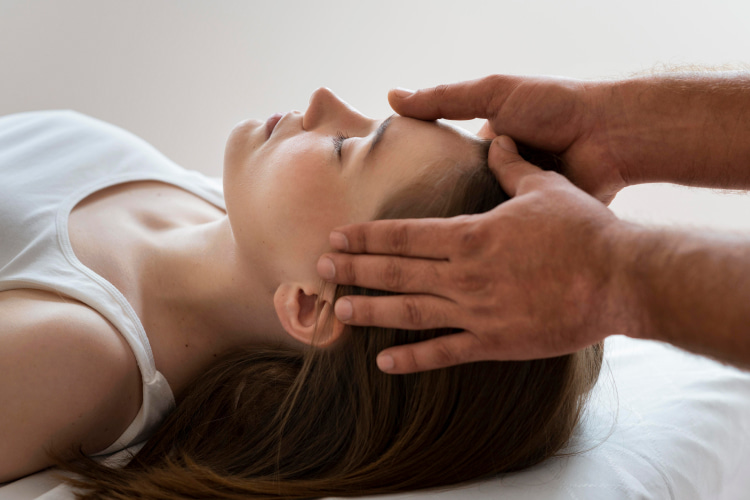These days, everyone is used to treatment with pills and other medications. Although, there are other methods as well. They usually do not cause much damage to the liver and stomach. We are talking about manual therapy. With the help of the right chiropractic techniques, you can cut many problems in the body. Chiropractic care can help with these headaches:
- muscular tension (spasms in the muscles of the head and neck);
- post-traumatic headaches (after a head injury);
- migraines;
- abusive.
Separately, we should mention abusive pain. If a person hasn’t had a headache, it won’t start hurting from pills. But a person can have headaches before. And people, instead of getting to the bottom of the cause and treating it, just take painkillers. This approach arises an unpleasant situation. The body gets used to the drugs, and that’s it. Without them, the headache will hurt. And a chiropractor can help with headaches of all types. So, this is where chiropractic care comes in to help get out of the vicious circle.
Chiropractic Treatment for Headaches
Chiropractic treatment for headaches and dizziness is the influence of the hands. A doctor put it on the joints of the musculoskeletal system. Outwardly the technique resembles massage but has its functional features. If performed correctly, the procedure restores the patient’s intracerebral fluid circulation. Headaches go away, and vision improves.
The treatment is based on the idea that the body holds all the information about any health problem. The specialist can decipher this information and encourage the body to heal itself. The task of the technique is to:
- reduce the patient’s condition;
- solve the problem behind the complex symptoms.
Chiropractic treatment, in combination with traditional methods, produces stunning results.
There are many chiropractic techniques for migraine. Most often, chiropractic treatment for headaches and dizziness is based on the craniosacral process. The essence of the technique is painless palpation of the patient’s entire body. This treatment has a positive effect on the entire body. Soft tissue chiropractic techniques also have a positive effect on the overall condition of patients. You can read in more detail about treatment from a chiropractor for neck pain and headaches below.
Craniosacral technique
The craniosacral system includes elements from the skull to the sacrum and coccyx. This system includes the spinal cord and brain. So, a functional imbalance in this area can lead to central nervous system disorders. A competent specialist performs a palpation technique to restore mobility in:
- the system’s fascias;
- sutures;
- membranes, and other tissues.
As a result, the microcirculation of cerebral fluid improves, and the headache disappears.
Soft tissue chiropractic technique
Soft tissue techniques of manual therapy allow restoration of:
- normal muscle tone;
- the elasticity of fasciae;
- normal pressure in the sheaths of the neurovascular bundles;
- mobility of all joint elements.
Years of research have shown good results of this chiropractic treatment for headaches. Soft-tissue chiropractic techniques have proven to be the most effective for tension headaches.
Besides a decrease in pain syndrome, patients experienced an increase:
- in their mood;
- work capacity;
- sleep, and cerebral hemodynamic indices.
Spinal Adjustments
Spinal adjustments are a key component of chiropractic care for migraine. This technique involves the skilled manipulation of the spine. It is necessary to improve its alignment and function. Chiropractors use their hands or specialized instruments. They can apply controlled pressure to specific vertebrae or joints along the spine. The chiropractor applies gentle force to the targeted area during a spinal adjustment. So he can restore proper alignment, reduce tension, and reduce nerve irritation. By realigning the spine, spinal adjustments help relieve stress on the:
- muscles;
- ligaments;
- nerves in the neck and upper back.
All these factors may contribute to headache symptoms.
Posture Correction
Poor posture, especially in the neck and upper back, can contribute to:
- muscle tension;
- spinal misalignments;
- nerve irritation.
So it can lead to headaches. Chiropractors test a patient’s posture to choose treatment for neck pain and headaches. They guide proper alignment and ergonomics to address these issues.
By improving posture, chiropractic care aims to reduce strain on the muscles. It minimizes the likelihood of headaches. Chiropractors educate patients on maintaining good posture throughout daily activities, including:
- sitting;
- standing;
- sleeping.
They may recommend specific exercises and stretches. It helps strengthen the muscles that support proper posture. Additionally, chiropractors may recommend ergonomic modifications in the workplace or at home. They can create an environment supporting good posture. It may involve adjusting the height and positioning of chairs, desks, and computer screens. This chiropractic treatment for headaches will ensure proper alignment and reduce stress on the spine.

How to Change your Lifestyle to Prevent Headaches
Making lifestyle changes can play a significant role in preventing headaches. Here are some recommendations to consider:
- Maintain a regular sleep schedule. Aim for consistent sleep patterns, ensuring you get enough quality sleep each night.
- Combat stress and emotional tension. Headache patients are often perfectionists who feel responsible for everything. They are under tremendous pressure. Strong ambitions lead to tension and stress. And they can cause migraine with a corresponding tendency. It is possible to minimize emotional tension and worries with:
- the help of harmless medications (valerian, for example);
- treatment from chiropractor for neck pain and headaches;
- through sessions with a psychologist.
3. Stay hydrated. Drink adequate water throughout the day to prevent dehydration, which can be a common trigger for headaches.
4. Eat a balanced diet. You have to incorporate nutritious foods, and avoid skipping meals. You should limit your intake of processed foods, caffeine, and alcohol. As these can contribute to headaches.

When should I see a chiropractor for a headache?
You should consider seeing a chiropractor for a headache if:
- Headaches are recurring or persistent. You are not able to manage them by over-the-counter medications or lifestyle changes.
- Headaches go with neck or upper back pain. Headaches often have a musculoskeletal component. If you notice concurrent neck or upper back pain, chiropractic treatment for headaches may help.
- Headaches are triggered by specific movements or positions. Certain movements or positions worsen your headaches.
- Headaches are a result of recent trauma or injury. You’ve been involved in a car accident, sports injury, or any other physical trauma.
Conclusion
In conclusion, if you’re seeking effective relief from headaches, the skilled chiropractors from All Injury Rehab will help with headaches by can be an excellent choice. Whether it’s spinal adjustments, soft tissue therapy, or lifestyle modifications, their goal is to help alleviate your headaches and improve your overall quality of life. Don’t let headaches hold you back any longer. Schedule a consultation with All Injury Rehab today. So you will take the first step towards lasting headache relief.
FAQ
What will a chiropractor do for headaches?
A chiropractor will assess your spinal alignment, muscle tension, and overall posture to identify any issues that may be contributing to your headaches.
Can a chiropractor help with headaches and dizziness?
Yes, chiropractors can often help with headaches and dizziness. By addressing underlying musculoskeletal issues, chiropractic care aims to alleviate these symptoms and improve overall well-being.
What are the contraindications to chiropractic care?
Contraindications to chiropractic care may include severe osteoporosis and spinal fractures. Spinal infections, certain cancers, and recent surgeries or injuries are also among them.
How soon can I get rid of headaches with chiropractic care?
Some individuals may experience relief after a few sessions, while others may require longer-term care to achieve significant improvement. The durability depends on many different factors.


Related posts
Today is an era dominated by digital conveniences and desk-bound occupations. So, the effects of a sedentary lifestyle have emerged as a pervasive concern.
Our guide aims to equip people with the knowledge to understand the intricacies of internal injuries. They are arising as a result of car accidents. Join us on this informative trip.
Beyond merely treating injuries, chiropractors work to enhance the body's biomechanics. It allows sportsmen to move more potently and reduces the risk of future injuries.